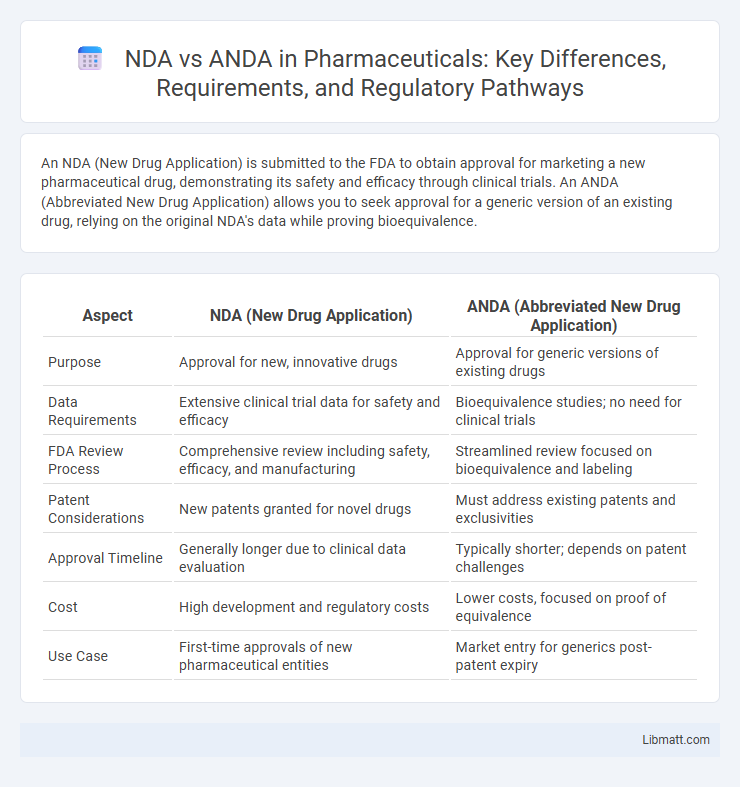An NDA (New Drug Application) is submitted to the FDA to obtain approval for marketing a new pharmaceutical drug, demonstrating its safety and efficacy through clinical trials. An ANDA (Abbreviated New Drug Application) allows you to seek approval for a generic version of an existing drug, relying on the original NDA's data while proving bioequivalence.
Table of Comparison
| Aspect | NDA (New Drug Application) | ANDA (Abbreviated New Drug Application) |
|---|---|---|
| Purpose | Approval for new, innovative drugs | Approval for generic versions of existing drugs |
| Data Requirements | Extensive clinical trial data for safety and efficacy | Bioequivalence studies; no need for clinical trials |
| FDA Review Process | Comprehensive review including safety, efficacy, and manufacturing | Streamlined review focused on bioequivalence and labeling |
| Patent Considerations | New patents granted for novel drugs | Must address existing patents and exclusivities |
| Approval Timeline | Generally longer due to clinical data evaluation | Typically shorter; depends on patent challenges |
| Cost | High development and regulatory costs | Lower costs, focused on proof of equivalence |
| Use Case | First-time approvals of new pharmaceutical entities | Market entry for generics post-patent expiry |
Overview of NDA and ANDA
The New Drug Application (NDA) is a comprehensive submission to the FDA seeking approval for new pharmaceutical drugs, detailing clinical trial data, safety, and efficacy. The Abbreviated New Drug Application (ANDA) enables approval of generic versions of previously approved drugs by demonstrating bioequivalence without requiring extensive clinical trials. NDAs involve original drug development, while ANDAs focus on cost-effective market entry via generics, ensuring similar therapeutic effects to the branded counterparts.
Definition: What is an NDA?
An NDA, or New Drug Application, is a formal request submitted to the FDA for approval to market a new pharmaceutical drug in the United States. It contains comprehensive data on the drug's safety, efficacy, manufacturing processes, and labeling. Understanding an NDA is essential for Your pharmaceutical development and regulatory strategy to ensure compliance and timely market entry.
Definition: What is an ANDA?
An Abbreviated New Drug Application (ANDA) is a request submitted to the FDA for approval to market a generic version of an already approved brand-name drug. Unlike a New Drug Application (NDA), an ANDA does not require extensive clinical trial data to demonstrate safety and efficacy, relying instead on the original drug's FDA approval and bioequivalence studies. Your understanding of ANDA is essential when seeking cost-effective alternatives to branded medications.
Key Differences Between NDA and ANDA
NDA (New Drug Application) requires comprehensive clinical trial data demonstrating safety and efficacy for new drugs, while ANDA (Abbreviated New Drug Application) focuses on proving bioequivalence to an already approved brand-name drug, bypassing extensive clinical trials. NDA involves a lengthy and costly approval process reflecting original drug innovation, whereas ANDA streamlines generic drug approval to promote market competition and access. Patent and exclusivity protections also differ, with NDAs often linked to exclusive marketing rights, unlike ANDAs which rely on patent expirations of branded drugs.
Regulatory Requirements for NDA
The New Drug Application (NDA) requires comprehensive data demonstrating a drug's safety, efficacy, and manufacturing quality, submitted to the FDA for approval before marketing. It must include preclinical and clinical trial results, detailed labeling information, and chemistry, manufacturing, and controls (CMC) documentation. NDAs undergo rigorous review timelines and post-marketing surveillance to ensure ongoing compliance with regulatory standards.
Regulatory Requirements for ANDA
ANDA (Abbreviated New Drug Application) requires comprehensive regulatory documentation demonstrating that the generic drug is bioequivalent to the original branded drug without needing to repeat extensive clinical trials. The FDA mandates strict adherence to quality control standards, labeling consistency, and manufacturing process specifications for ANDA approval. Your submission must include detailed chemistry, manufacturing, and controls (CMC) data to ensure the generic product's safety, efficacy, and performance match the reference listed drug.
Approval Processes: NDA vs ANDA
The New Drug Application (NDA) approval process requires extensive clinical trial data demonstrating safety and efficacy, often involving multi-phase human studies and comprehensive FDA review. In contrast, the Abbreviated New Drug Application (ANDA) approval focuses on proving bioequivalence to an already approved reference drug, omitting the need for extensive clinical trials. NDA approval timelines are typically longer and costlier due to the rigorous data requirements, whereas ANDA approvals expedite generic drug market entry through streamlined evaluations.
Data Submission: Clinical Trials vs Bioequivalence
NDA (New Drug Application) requires extensive clinical trial data demonstrating safety and efficacy, including multiple phases of human testing and detailed clinical study reports. ANDA (Abbreviated New Drug Application) focuses on bioequivalence studies comparing the generic drug to the innovator product, eliminating the need for clinical trials. Understanding these distinctions in data submission helps ensure your application meets FDA requirements for drug approval.
Timeline and Costs for NDA and ANDA
The NDA (New Drug Application) process typically takes 10 to 12 years and costs upwards of $2.6 billion, reflecting extensive clinical trials for safety and efficacy. In contrast, the ANDA (Abbreviated New Drug Application) pathway is much shorter, often completed within 1 to 3 years, with costs ranging from $1 to $5 million due to the absence of clinical trials, focusing instead on demonstrating bioequivalence. The significant disparity in both timeline and costs underscores the ANDA's role in facilitating faster market entry for generic drugs compared to the NDA's requirement for comprehensive data on novel pharmaceuticals.
Implications for Pharmaceutical Companies
NDA (New Drug Application) and ANDA (Abbreviated New Drug Application) serve distinct regulatory pathways that significantly impact pharmaceutical companies' market strategies and development timelines. An NDA requires comprehensive clinical data demonstrating safety and efficacy for new drugs, which entails substantial investment in research and longer approval periods, whereas an ANDA focuses on demonstrating bioequivalence for generic drug approval, offering cost-effective entry into the market with faster regulatory clearance. Your choice between NDA and ANDA influences patent lifespan management, competitive positioning, and resource allocation within the pharmaceutical industry.
NDA vs ANDA Infographic

 libmatt.com
libmatt.com